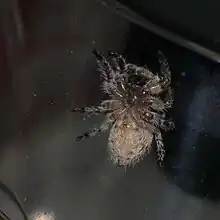Langelurillus kenyaensis
Langelurillus kenyaensis is a species of jumping spider in the genus Langelurillus that is endemic in Kenya. It was first described in 2016 by Angelika Dawidowicz and Wanda Wesołowska, and is named after the country where it was first identified. The spider is small, with a black oval carapace that is typically 2.8 mm (0.11 in) long and a blackish-grey spherical abdomen 2.2 mm (0.087 in) long. The short legs are orangish-brown have large dark markings, brown hairs and brown spines. Only the female has been described. It has a small epigyne and longer seminal ducts that are looped, which distinguishes it from the otherwise similar Langelurillus primus.
| Langelurillus kenyaensis | |
|---|---|
 | |
| A spider of the Langelurillus genus | |
| Scientific classification | |
| Domain: | Eukaryota |
| Kingdom: | Animalia |
| Phylum: | Arthropoda |
| Subphylum: | Chelicerata |
| Class: | Arachnida |
| Order: | Araneae |
| Infraorder: | Araneomorphae |
| Family: | Salticidae |
| Subfamily: | Salticinae |
| Genus: | Langelurillus |
| Species: | L. kenyaensis |
| Binomial name | |
| Langelurillus kenyaensis Dawidowicz & Wesołowska, 2016 | |
Taxonomy
Langelurillus kenyaensis was first described by Angelika Dawidowicz and Wanda Wesołowska in 2016.[1] It was one of over 500 species identified by the Polish arachnologist during her career.[2] It was allocated it to the genus Langelurillus, which had been raised by Maciej Próchniewicz in 1994.[3] The genus is related to Aelurillus and Langona but the spiders are smaller and, unlike these genera and Phlegra, they lack the parallel stripes on the back of the body that is feature of the majority of these spiders.[4] In 2015, Wayne Maddison listed the genus in the subtribe Aelurillina, which also contains Aelurillus, Langona and Phlegra, in the tribe Aelurillini, within the subclade Saltafresia in the clade Salticoida.[5] In 2016, Jerzy Prószyński placed the same genera in a group named Aelurillines based on the shape of the spiders' copulatory organs.[6]
Description
Langelurillus kenyaensis is a small spider. The male has a cephalothorax that is typically 2.8 mm (0.11 in) long and 1.9 mm (0.075 in) wide. The carapace is a black high oval and covered with greyish-white hairs. The eye field is also black. The clypeus has long translusclent hairs. The chelicerae are light brown with one very small tooth visible to the front. The labium is brownish with pale tips. The abdomen is typically 2.2 mm (0.087 in) long and 2.5 mm (0.098 in) wide and rounder than the carapace, nearly spherical. It is blackish-grey and covered with dense grey hairs. The underside is light. The spinnerets are long and yellow with dark ends and the short legs are orangish-brown with large dark markings, brown hairs and brown spines. The epigyne is very small. The seminal ducts, which are longer and more convoluted than those on the similar Langelurillus primus, form a loop and lead to bean-shaped and very sclerotised spermathecae.[7]
Distribution
Almost all, if not all, Langelurillus spiders live in sub-Saharan Africa.[8] Langelurillus kenyaensis was first identified in Kenya, after which it is named. The holotype was discovered in 1965 on Mount Elgon.[7] It has only been found in that area of the country.[9]
References
Citations
- World Spider Catalog (2017). "Langelurillus kenyaensis Dawidowicz & Wesolowska, 2016". World Spider Catalog. 18.0. Bern: Natural History Museum. Retrieved 7 May 2017.
- Wiśniewski 2020, p. 6.
- Próchniewicz 1994, p. 27.
- Próchniewicz 1994, p. 28.
- Maddison 2015, p. 279.
- Prószyński 2017, p. 95.
- Dawidowicz & Wesołowska 2016, p. 448.
- Logunov & Azarkina 2018, p. 120.
- Kioko et al. 2021, p. 164.
Bibliography
- Dawidowicz, Angelika; Wesołowska, Wanda (2016). "Jumping Spiders (Araneae: Salticidae) of Kenya Collected by Åke Holm". Annales Zoologici. 66 (3): 437–466. doi:10.3161/00034541ANZ2016.66.3.010. S2CID 89556915.
- Kioko, Grace M.; Marusik, Yuri M.; Li, Shuqiang; Kioko, Esther N.; Ji, Liqiang (2021). "Checklist of the spiders (Araneae) of Kenya". African Invertebrates. 62 (1): 47–229. doi:10.3897/AfrInvertebr.62.58776. S2CID 234148710.
- Logunov, Dmitri V.; Azarkina, Galina N. (2018). "Redefinition and partial revision of the genus Stenaelurillus Simon, 1886 (Arachnida, Araneae, Salticidae)". European Journal of Taxonomy. 430: 1–126. doi:10.5852/ejt.2018.430.
- Maddison, Wayne P. (2015). "A phylogenetic classification of jumping spiders (Araneae: Salticidae)". The Journal of Arachnology. 43 (3): 231–292. doi:10.1636/arac-43-03-231-292. S2CID 85680279.
- Próchniewicz, Maciej (1994). "The jumping spiders of the Ethiopian Region. Part I. New genus Langelurillus gen. n. (Araneae, Salticidae) from Kenya". Annales Zoologici, Warszawa (45): 27–31.
- Prószyński, Jerzy (2017). "Pragmatic classification of the World's Salticidae (Araneae)". Ecologica Montenegrina. 12: 1–133. doi:10.37828/em.2017.12.1.
- Wiśniewski, Konrad (2020). "Over 40 years with jumping spiders: on the 70th birthday of Wanda Wesołowska". Zootaxa. 4899 (1): 5–14. doi:10.11646/zootaxa.4899.1.3. PMID 33756825. S2CID 232337200.